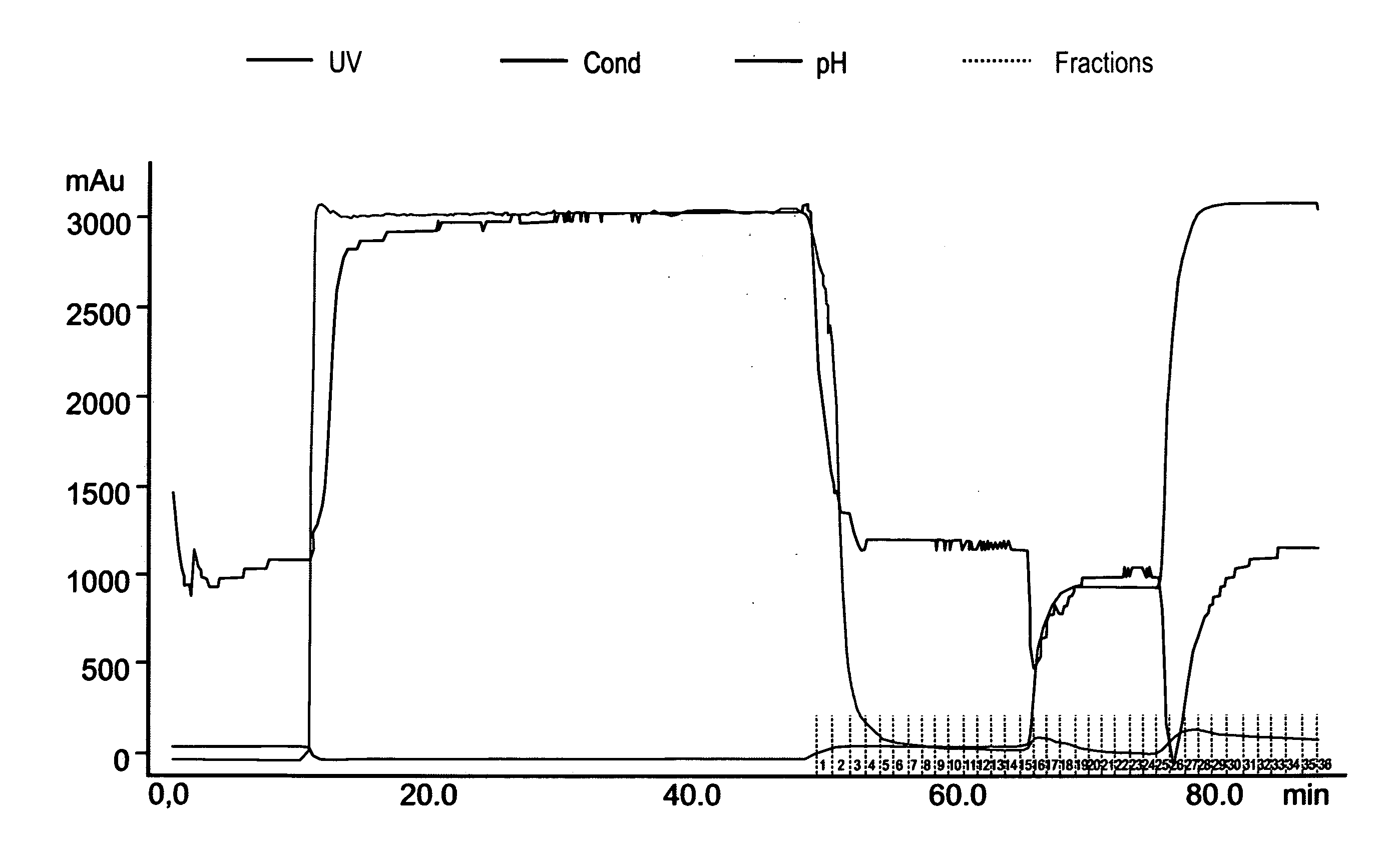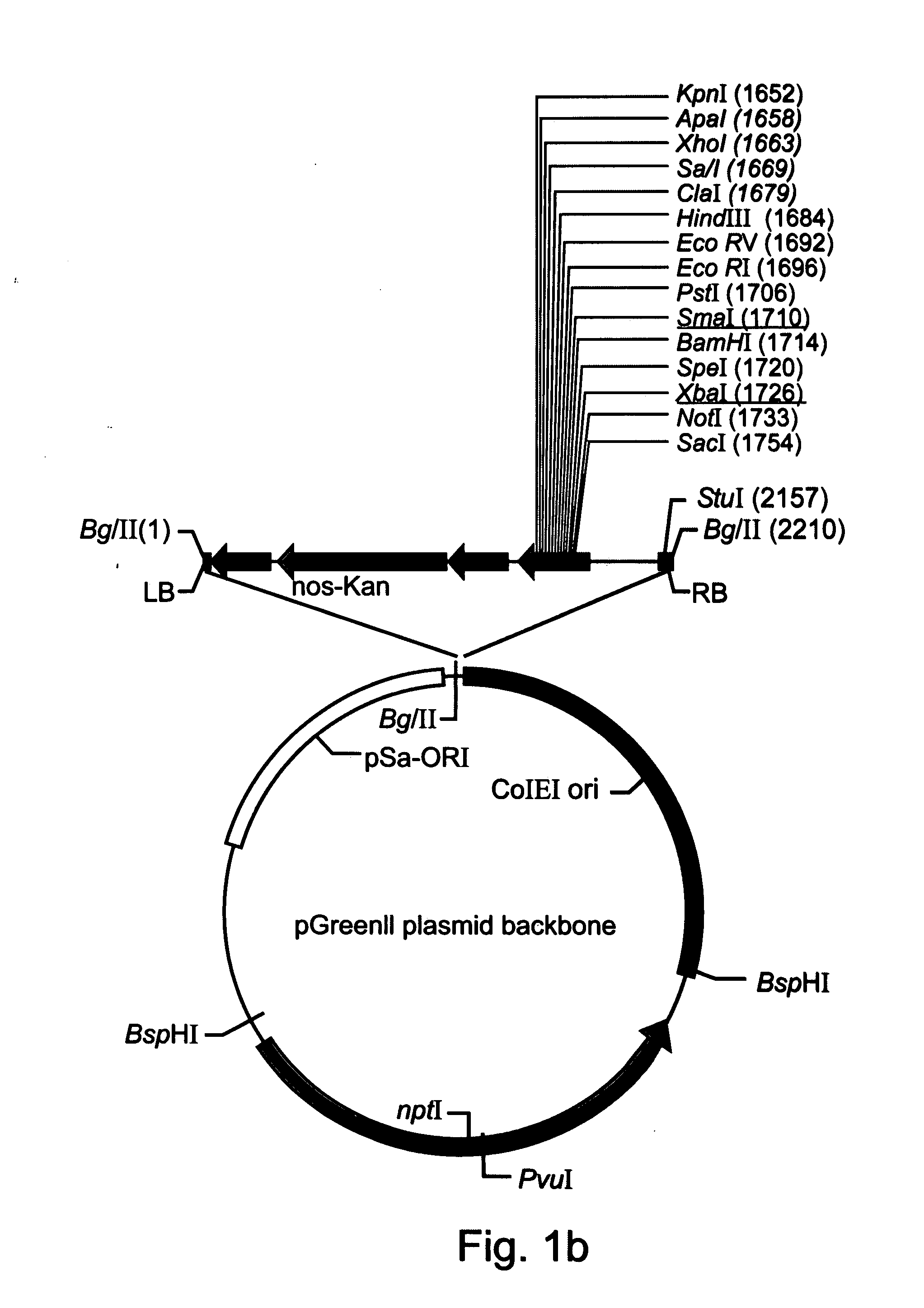Production of high mannose proteins in plant culture
- Summary
- Abstract
- Description
- Claims
- Application Information
AI Technical Summary
Benefits of technology
Problems solved by technology
Method used
Image
Examples
example 1
Construction of Expression Plasmid
[0212] This Example describes the construction of an exemplary expression plasmid, used with regard to the Examples below, in more detail.
[0213] The cDNA coding for hGCD (ATTC clone number 65696) was amplified using the forward: 5′ CAGAATTCGCCCGCCCCTGCA 3′ (also denoted by SEQ ID NO: 1) and the reverse: 5′ CTCAGATCTTGGCGATGCCACA 3′ (also denoted by SEQ ID NO: 2) primers.
[0214] The purified PCR DNA product was digested with endonucleases EcoRI and BglII (see recognition sequences underlined in the primers) and ligated into an intermediate vector having an expression cassette CE-T digested with the same enzymes. CE-T includes ER targeting signal MKTNLFLFLIFSLLLSLSSAEA (also denoted by SEQ ID NO: 3) from the basic endochitinase gene [Arabidopsis thaliana], and vacuolar targeting signal from Tobacco chitinase A: DLLVDTM* (also denoted by SEQ ID NO: 4).
[0215] The expression cassette was cut and eluted from the intermediate vector and ligated into the...
example 2
Transformation of Carrot Cells and Screening for Transformed cells expressing rhGCD
[0218] This Example describes an exemplary method for transforming carrot cells according to the present invention, as used in the Examples below.
[0219] Transformation of carrot cells was performed by Agrobacterium transformation as described previously by [Wurtele and Bulka (1989) ibid.]. Genetically modified carrot cells were plated onto Murashige and Skoog (MS) agar medium with antibiotics for selection of transformants. As shown by FIG. 2, extracts prepared from arising calli were tested for expression of GCD by Western blot analysis using anti hGCD antibody, and were compared to Cerezyme standard (positive control) and extracts of non-transformed cells (negative control). Of the various calli tested, one callus (number 22) was selected for scale-up growth and protein purification.
[0220] The Western blot was performed as follows.
[0221] For this assay, proteins from the obtained sample were sep...
example 3
Purification of Recombinant Active hGCD Protein from Transformed Carrot Cells
[0230] Recombinant h-GCD expressed in transformed carrot cells was found to be bound to internal membranes of the cells and not secreted to the medium. Mechanically cell disruption leaves the rGCD bound to insoluble membrane debris (data not shown). rGCD was then dissolved using mild detergents, and separated from cell debris and other insoluble components. The soluble enzyme was further purified using chromatography techniques, including cation exchange and hydrophobic interaction chromatography columns as described in Experimental procedures.
[0231] In order to separate the medium from the insoluble GCD, frozen cell cake containing about 100 g wet weight cells was thawed, followed by centrifugation at 17000× g for 20 min at 4° C. The insoluble materials and intact cells were washed by re-suspension in 100 ml washing buffer (20 mM sodium phosphate pH 7.2, 20 mM EDTA), and precipitated by centrifugation at...
PUM
| Property | Measurement | Unit |
|---|---|---|
| Time | aaaaa | aaaaa |
| Electrical conductance | aaaaa | aaaaa |
| Electrical conductance | aaaaa | aaaaa |
Abstract
Description
Claims
Application Information
 Login to View More
Login to View More - R&D
- Intellectual Property
- Life Sciences
- Materials
- Tech Scout
- Unparalleled Data Quality
- Higher Quality Content
- 60% Fewer Hallucinations
Browse by: Latest US Patents, China's latest patents, Technical Efficacy Thesaurus, Application Domain, Technology Topic, Popular Technical Reports.
© 2025 PatSnap. All rights reserved.Legal|Privacy policy|Modern Slavery Act Transparency Statement|Sitemap|About US| Contact US: help@patsnap.com



